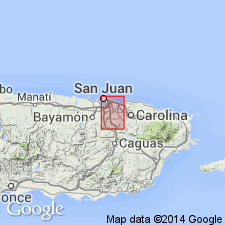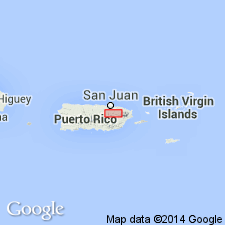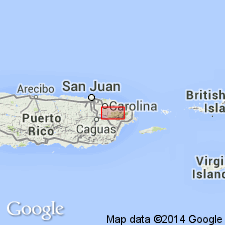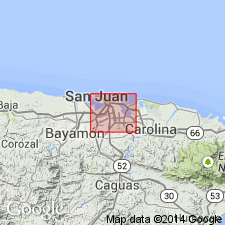
- Usage in publication:
-
- Trujillo Alto limestone*
- Modifications:
-
- Overview
Summary:
The Trujillo Alto Limestone of Berkey (1915), here adopted, consists of blue-gray to light-gray, massive, richly fossiliferous limestone. Conformably overlies the Monacillo Formation; conformably underlies the Figuera Volcanics. Thickness up to 900 ft. Age is Late Cretaceous based on fossils. Stratigraphic position may be at the top of the Upper Cretaceous section and immediately below the Paleocene or lower Eocene.
Source: GNU records (USGS DDS-6; Reston GNULEX).

- Usage in publication:
-
- Trujillo Alto Limestone Member*
- Modifications:
-
- Revised
Summary:
The Monacillo Formation is here revised to include the Trujillo Alto Limestone Member, mapped by Kaye (1959) as the Trujillo Alto Limestone, but shown by recent mapping to be a more restricted unit than Kaye had shown and overlain in most places by bedded mudstone, sandstone, and siltstone of the Monacillo. Monacillo unconformably overlies the Leprocomio Siltstone Member of the Guaynabo; unconformably underlies the Guaracanal Andesite. Is stratigraphically equivalent to the La Muda Formation. Trujillo Alto is at the top of the Monacillo and is overlain by limestone correlated with basal limestone in the Paleocene Guaracanal. Age is Late Cretaceous (probably late Maastrichtian) based on fossils in the Trujillo Alto Limestone Member.
Source: GNU records (USGS DDS-6; Reston GNULEX).

- Usage in publication:
-
- Trujillo Alto Limestone Member*
- Modifications:
-
- Age modified
Summary:
Stratigraphic relationships suggest a disconformity between the Leprocomio Mudstone Member of the Frailes and the Trujillo Alto Limestone Member of the Monacillo of about 450 m of Cretaceous rocks. Age of the Monacillo is set by late Campanian Leprocomio and Late Cretaceous or possibly Tertiary Trujillo Alto. Age is Campanian or Maastrichtian, possible early Tertiary in upper part.
Source: GNU records (USGS DDS-6; Reston GNULEX).

- Usage in publication:
-
- Trujillo Alto Limestone Member*
- Modifications:
-
- Age modified
Summary:
Age of the Trujillo Alto Limestone Member of the Monacillo Formation is Late Cretaceous.
Source: GNU records (USGS DDS-6; Reston GNULEX).
For more information, please contact Nancy Stamm, Geologic Names Committee Secretary.
Asterisk (*) indicates published by U.S. Geological Survey authors.
"No current usage" (†) implies that a name has been abandoned or has fallen into disuse. Former usage and, if known, replacement name given in parentheses ( ).
Slash (/) indicates name conflicts with nomenclatural guidelines (CSN, 1933; ACSN, 1961, 1970; NACSN, 1983, 2005, 2021). May be explained within brackets ([ ]).

